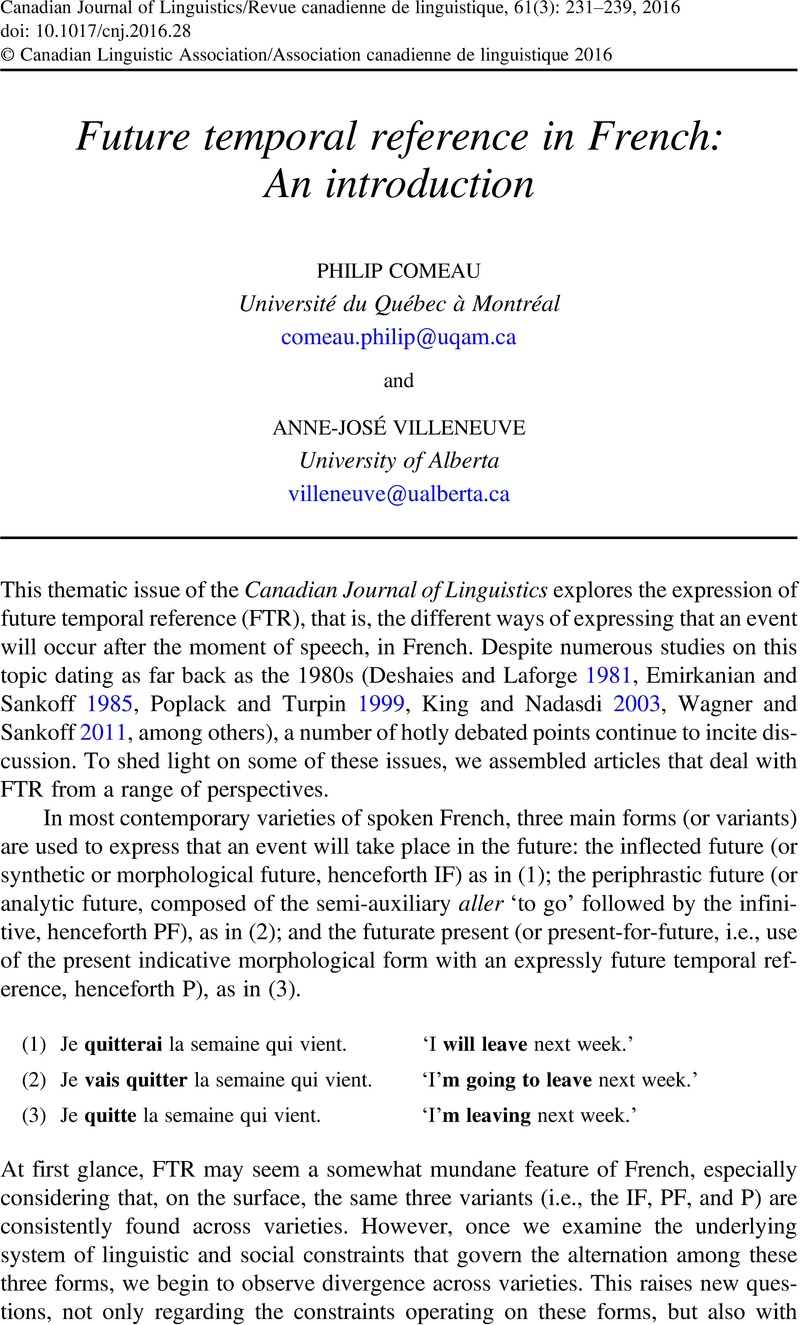No CrossRef data available.
Article contents
Future temporal reference in French: An introduction
Published online by Cambridge University Press: 15 November 2016
Abstract
An abstract is not available for this content so a preview has been provided. Please use the Get access link above for information on how to access this content.

- Type
- Introduction
- Information
- Copyright
- © Canadian Linguistic Association/Association canadienne de linguistique 2016
References
References
Auger, Julie, and Villeneuve, Anne-José. 2015. Looking at contemporary Picard from different angles: The relevance of variationist methods for European language policy. Paper presented at 44th New Ways of Analyzing Variation (NWAV 44), Toronto.Google Scholar
Blondeau, Hélène. 2006. La trajectoire de l'emploi du futur chez une cohorte de Montréalais francophones entre 1971 et 1995. Revue canadienne de linguistique appliquée 9(2): 73–98.Google Scholar
Champion, James Joseph. 1978. The periphrastic futures formed by the Romance reflexes of vado (ad) plus infinitive. North Carolina Studies in the Romance Languages and Literatures. Chapel Hill, NC: Department of Romance Languages.Google Scholar
Comeau, Philip. 2015. Vestiges from the grammaticalization path: The expression of future temporal reference in Acadian French. Journal of French Language Studies 25(3): 339–365.Google Scholar
Deshaies, Denise, and Laforge, Ève. 1981. Le futur simple et le futur proche dans le français parlé dans la ville de Québec. Langues et Linguistique 7: 21–37.Google Scholar
Emirkanian, Louisette, and Sankoff, David. 1985. Le futur simple et le futur périphrastique. In Les tendances dynamiques du français parlé à Montréal, ed. Lemieux, Monique, and Cedergren, Henrietta, 189–204. Quebec: Office de la langue française.Google Scholar
Fleischman, Suzanne. 1982. The future in thought and language. Diachronic evidence from Romance, Cambridge Studies in Linguistics London. Cambridge: Cambridge University Press.Google Scholar
Gasté, Armand. 1888. Les serments de Strasbourg: étude historique, critique et philologique. 6th ed. Paris: Eugène Belin.Google Scholar
Grimm, D. Rick. 2010. A real-time study of future temporal reference in spoken Ontarian French. University of Pennsylvania Working Papers in Linguistics 16(2): Article 11.Google Scholar
Grimm, D. Rick. 2015. Grammatical variation and change in spoken Ontario French: The subjunctive mood and future temporal reference. Doctoral dissertation, York University.Google Scholar
Grimm, D. Rick, and Nadasdi, Terry. 2011. The future of Ontario French. Journal of French Language Studies 21(2): 173–189.Google Scholar
Gudmestad, Aarnes, Edmonds, Amanda, Donaldson, Bryan, and Carmichael, Katie. 2015. Future-time reference in Hexagonal French: Integrating the present indicative in a predictive model of variable use. Paper presented at 44th New Ways of Analyzing Variation (NWAV 44), Toronto.Google Scholar
King, Ruth, and Nadasdi, Terry. 2003. Back to the future in Acadian French. Journal of French Language Studies 13(3): 323–337.Google Scholar
Lebreton, Jules. 1901. Études sur la langue et la grammaire de Cicéron. Paris: Librarie Hachette.Google Scholar
Nadasdi, Terry, Mougeon, Raymond, and Rehner, Katherine. 2003. Emploi du ‘futur’ dans le français parlé des élèves d'immersion française. Journal of French Language Studies 13(2): 195–219.Google Scholar
Orozco, Rafael. 2005. Distribution of future time forms in Northern Colombian Spanish. In Selected proceedings of the 7th Hispanic linguistics symposium, ed. Eddington, David, 56–65. Somerville, MA: Cascadilla Proceedings Project.Google Scholar
Poplack, Shana, and Dion, Nathalie. 2009. Prescription vs. praxis: The evolution of future temporal reference in French. Language 85(3): 557–587.Google Scholar
Poplack, Shana, and Malvar, Elisabete. 2007. Elucidating the transition period in linguistic change: The expression of the future in Brazilian Portuguese. Probus 19(1): 121–169.Google Scholar
Poplack, Shana, and Turpin, Danielle. 1999. Does the Futur have a future in (Canadian) French? Probus 11(1): 133–164.Google Scholar
Roberts, Nicholas S. 2012. Future Temporal Reference in Hexagonal French. University of Pennsylvania Working Papers in Linguistics 18(2): Article 12.Google Scholar
Seutin, Émile. 1975. Description grammaticale du parler de l’Île-aux-Coudres, Québec. Montréal: Presses de l'Université de Montréal.Google Scholar
Villeneuve, Anne-José. 2011. A sociolinguistic study of Vimeu French. Doctoral dissertation, Indiana University.Google Scholar
Wagner, Suzanne Evans, and Sankoff, Gillian. 2011. Age grading in the Montréal French inflected future. Language Variation and Change 23(3): 275–313.Google Scholar
Zimmer, Dagmar. 1994. Le futur simple et le futur périphrastique dans le français parlé à Montréal. Langues et Linguistique 20: 213–226.Google Scholar
Literary Works Cited
Molière, . 1670. Monsieur de Pourceaugnac. www.toutmoliere.net (consulted on May 6, 2016)Google Scholar




